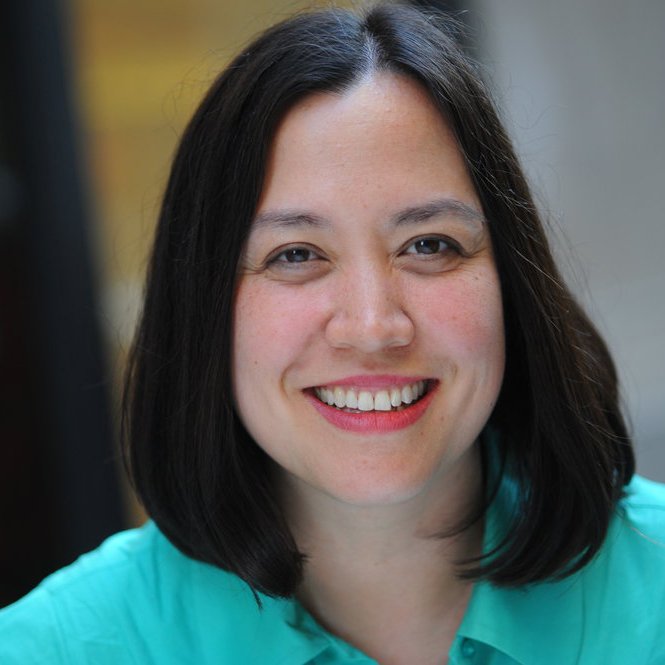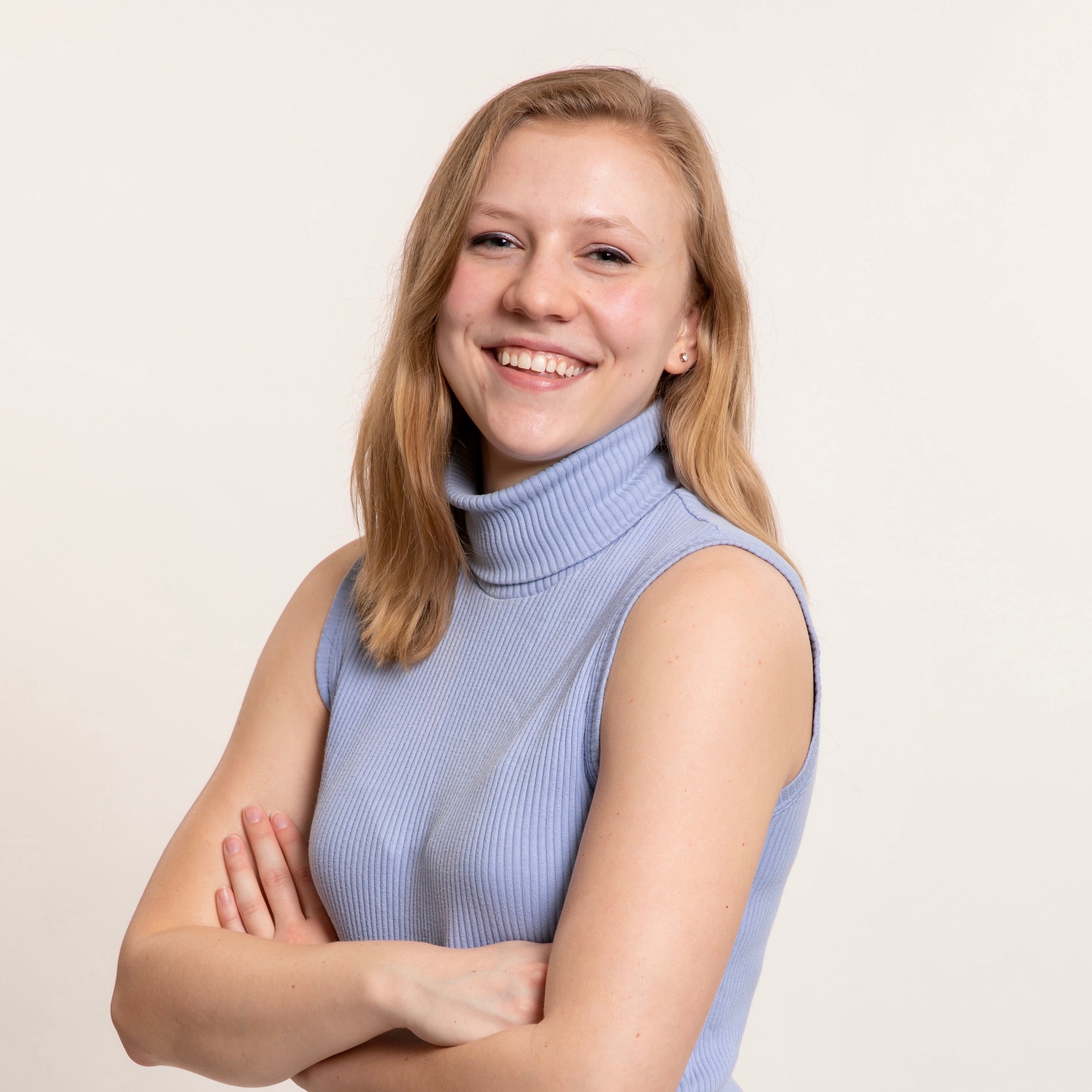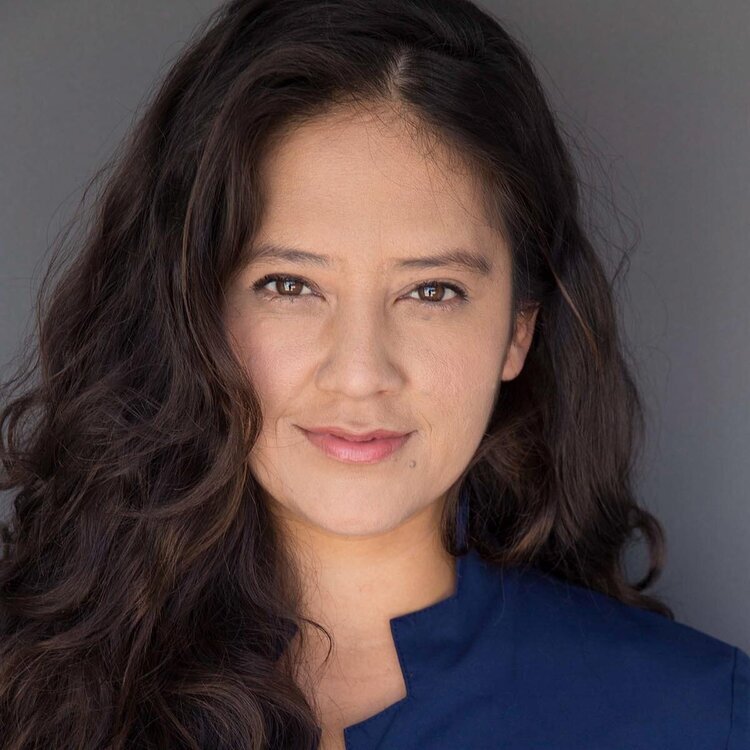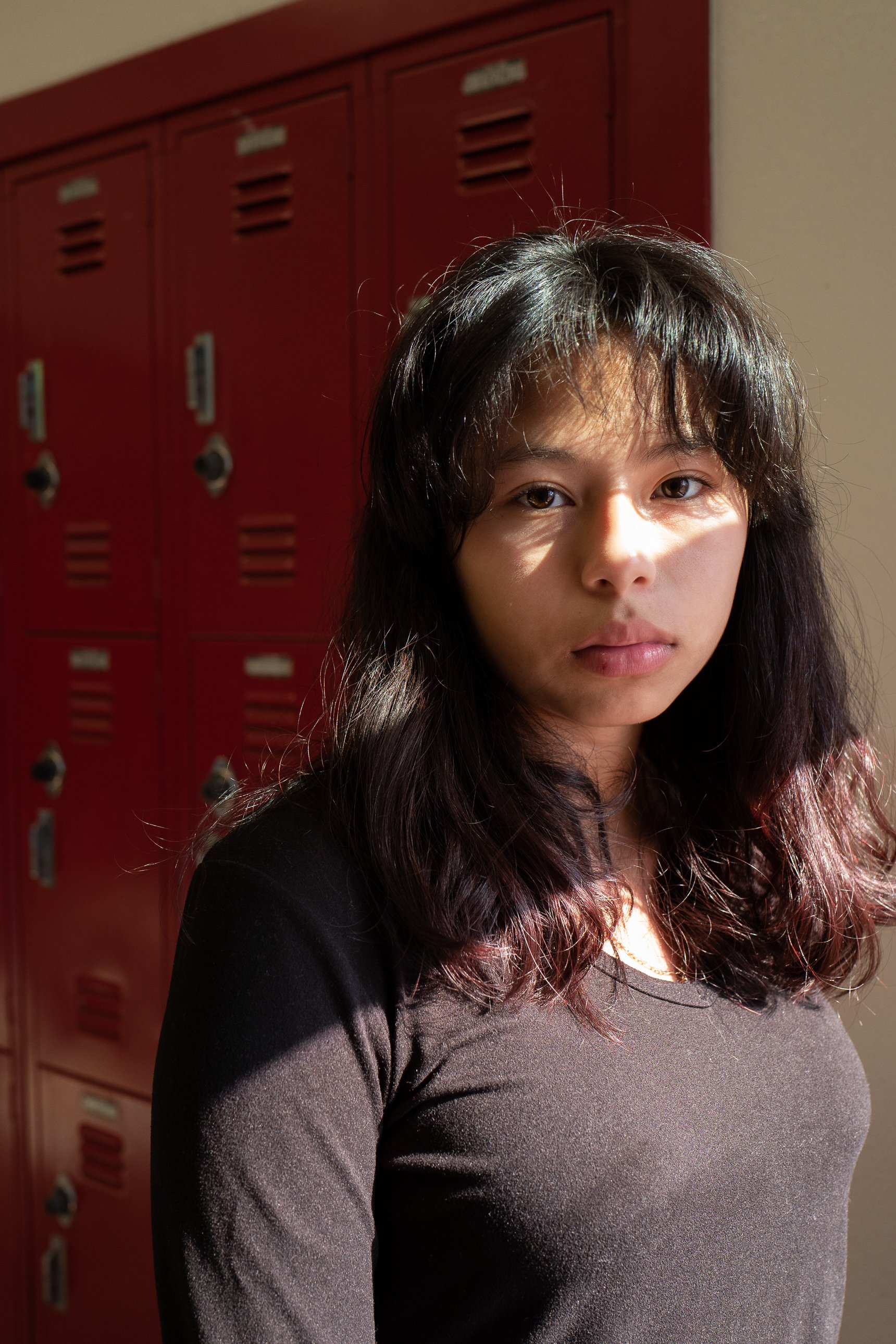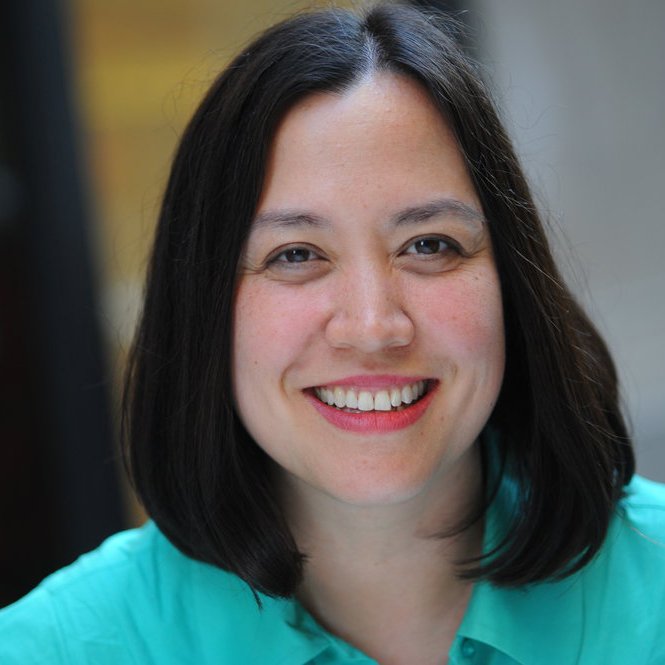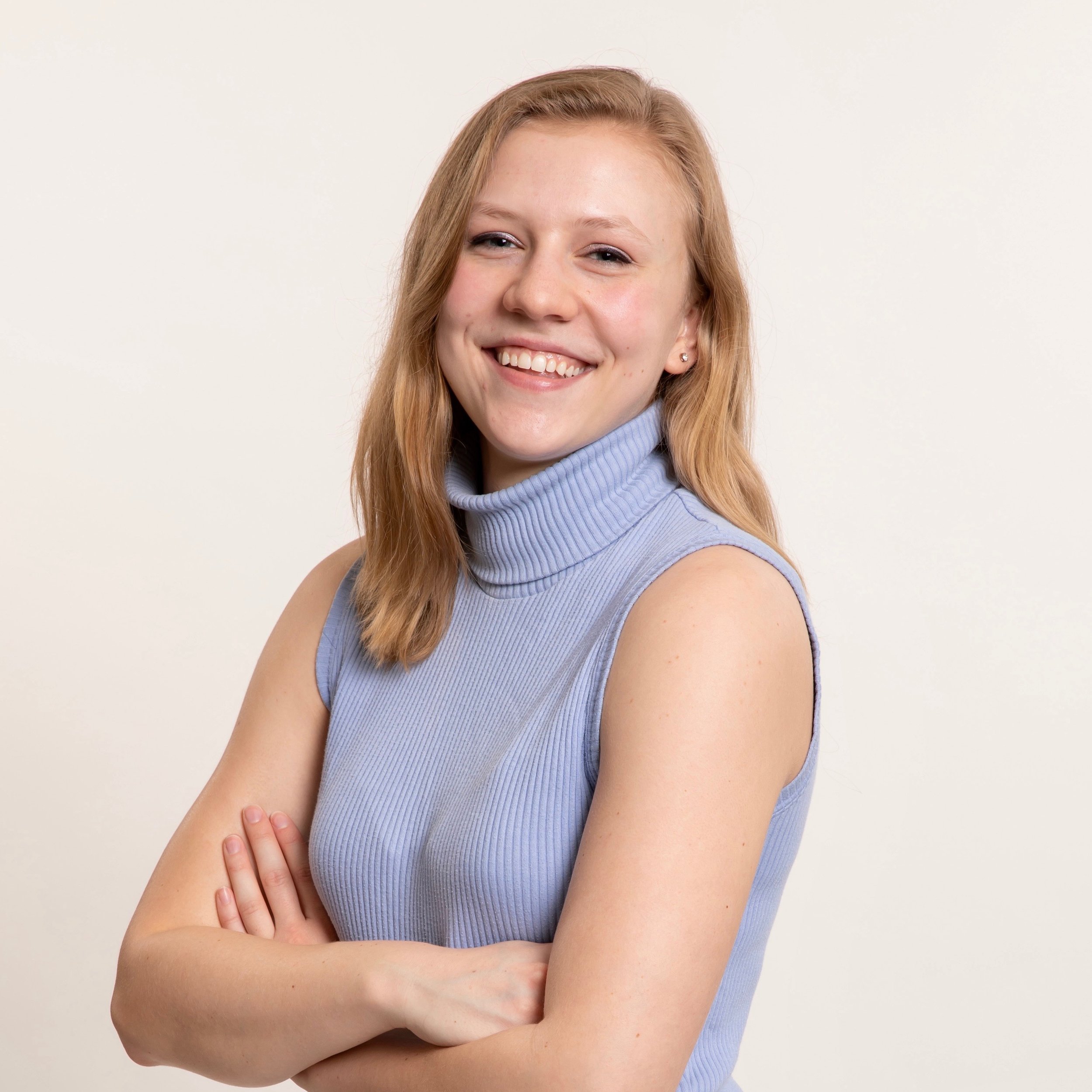Building a Brighter Future
A-lab fellow, Daniel Tran (left), leads students through the remainder of the class. Tran guides students step-by step through building digital collages on the computer. Photo by Zaydee Sanchez for palabra.
A high school program in Los Angeles brings students into the changing world of architecture
Editor’s note: Para leer este reportaje en español haga clic aquí.
Before joining the architecture prep program at the University of Southern California in her junior year of high school, Elida Mejia Elias planned to study health and become a doctor. She didn’t know what being an architect entailed and her only experience in design was rearranging the furniture in her room. Then she went through USC’s A-Lab program, and everything changed.
“A-Lab influenced me until this day. It opened my mind to see there’s more of what I could study. I could have an opportunity in the field,” says Mejia Elias, now a senior at The James A. Foshay Learning Center in Los Angeles.
‘The profession is realizing that we, as architects, are world builders and cultural curators.’
Mejia Elias awaits word on her college applications. As the first in her family to attend college, Mejia Elias is thinking about pursuing a degree in interior design. And after the A-Lab experience, many of her classmates are also open to studying architecture in college.
That sets Mejia Elias and her A-Lab classmates apart from most students of color: Few pursue careers in architecture or design, let alone consider it a line of study in higher education. While professions such as medicine and law have progressed in bringing students of color into pre-professional educational programs and launching careers, architecture lags behind.
As Elida Mejia Elias and her younger sister Genesis work on homework in their room, their nephews play with the smart speaker, Alexa. Photo by Zaydee Sanchez for palabra.
The majority of membership at the American Institute of Architects is white, according to a 2021 survey. Only 5.6% of AIA members are Hispanic; just under 7% are Asian; 2.3% are Black; and less than 1% identifies as Indigenous or Middle Eastern / North African. Programs like the USC A-Lab aim to change the field’s demographics.
“The profession is realizing that we, as architects, are world builders and cultural curators. If we’re going to do that, we have a responsibility we’ve been overlooking for centuries, to look out for those who do not have immense resources or extreme privilege,” says Kendall A. Nicholson, director of research and information at the Association of Collegiate Schools of Architecture. “When we look at the pipeline for Black, Indigenous, Latine, and Asian people, it’s very poor.”
Tough path to change the status quo
Why are the numbers so low? Advocates of change point to the cost of an architecture degree, the difficult path to becoming licensed, the lack of role models of color, and inexperience with the scope of career possibilities in architecture and design professions. Nicholson’s research found that, compared with their white peers, students of color worry more about the cost of a degree and low salaries in architecture, relative to other professions.
High school collaboration initiatives like USC’s A-Lab, and similar programs at the University of Michigan and Princeton University, hold the promise of increasing the numbers. Among graduates of the University of Michigan’s collaboration with Detroit Public Schools, many go on to pursue degrees in architecture, engineering, and the arts, according to Milton S. F. Curry, who helped develop the Michigan program when he was associate dean there. After he started a five-year stint as dean of USC’s architecture department in 2017, Curry forged a similar collaboration with the Los Angeles Unified School District.
Dr. Lauren Matchison, professor of practice at USC and director of college programs. Photo by Zaydee Sanchez for palabra.
The A-Lab program is just one initiative aimed at diversifying the ranks of college architecture studies.
“It's taken messaging, marketing, recruitment, and also actions,” such as reviewing the curriculum and recruiting diverse faculty members, says Curry, who oversaw growth in participation by students of color. The percentage of Black undergraduate architecture students nearly doubled from 4.2% to 8% of the department’s population between 2017 and 2022. The Latino population also rose, from 15.4% to 26%.
How A-Lab works
In the USC program, local students study architecture with USC faculty for three hours every weekday morning, in place of two high school classes. They learn to look at the world around them differently, from small objects that they draw in detail to the buildings and communities they travel through each day. They design and build architectural models. And they meet with architecture professionals on the USC campus and on field trips to local firms.
One meeting of note is time with Ernesto M. Vasquez, owner and chief executive officer of SVA Architects in Santa Ana, which focuses on affordable, mixed-income housing in urban centers and college campuses. When Vasquez speaks to students, his aim is broadening their perspective on architecture, beyond a stereotypical gentleman’s profession of building big houses for rich people. His firm designs faculty and student housing, housing above clinics or libraries, and other creative, mixed-use buildings that fill a need in underserved communities. That helps make the field relevant to many Hispanic and Latino students.
That experience convinced Mejia Elias to pursue a design or architecture career and make a lasting impact on the environment, following Vasquez’s example of contributing to the Latino community. “His family didn’t have anything” when he was young, Mejia Elias explains. “It made me see I can be like him one day.”
In the United States, her immigrant mother has little wealth. But she was able to buy a large house in El Salvador, in a farm community where Mejia Elias lived as a child. Her mother designed the home herself. “To see the architecture and people without money building it, and I’ve seen my family do it, it looks really beautiful,” she says. “She had the opportunity to make it better and help other people working there.”
‘I was shown that it’s a lot more than just drawing lines.’
Mejia Elias’ older brother works in construction, so he was able to help with her A-Lab projects. She now feels an obligation to succeed and not disappoint her family. “It’s a lot of pressure to not fail them and to do things right. They have a lot of high expectations of me,” she says.
Mejia Elias is already putting her design experience to use: she’s redone the bedroom she shares with her 8-year old sister, coloring it pink and blue and stringing lights to create some “girly vibes.” While she waits for word about her collegiate future, she’s spending time studying, fixing up her car, and working customer service and sales for a phone company.
First generation college students
Racial and ethnic groups experience unique roadblocks to higher education and careers in architecture. ASCA’s Nicholson studied diversity in the profession, and found that Latino students are the least likely to have a parent who attended college, compared with white, Asian, Black and multiracial students. “There’s a lot that you only understand by having attended a college. That, in and of itself, becomes a barrier,” he says.
The A-Lab program recruits 11th grade students from two Los Angeles high schools, Foshay Learning Center and Washington Preparatory High School, with a required 3.0 GPA and background in geometry. USC enrolls one cohort from Foshay in the fall and one from Washington Prep in the spring, with a goal of 14 to 16 students each. Students get a taste of life on the iconic USC campus. They earn college course credit upon graduation. And they get a leg up on a portfolio that can enhance a college application.
Because of the community demographics, the A-Lab cohorts tend to be majority Black and Hispanic, says Lauren Matchison, associate professor of practice and director of college programs for USC's architecture school. “We're targeting non-traditional, underrepresented students…Part of what we commit to them is assistance during the application period.”
Mejia Elias says she felt that support throughout her college application process. Matchison helped with feedback on her essays, suggested summer programs, alerted her to scholarship opportunities, and provided a college application coach. Even after her A-Lab studies, Mejia Elias continued to meet with Matchison, who visits the Foshay’s campus weekly to advise students on college and career plans – and bond over donuts. “I’m close to Ms. Matchison to this day,” she says.
Demystifying private universities
Another Los Angeles high schooler, Ashley Neponuceno, planned to attend a two-year community college program before applying to a four-year university. Like Mejia Elias, she’d be her family’s first in college.
But after the exposure to USC through A-Lab and support from its faculty, she applied to three private universities and several University of California campuses. The change in college plans grew from Matchison and her team’s information and coaching about applications, scholarships, and financial aid.
Neponuceno said she was encouraged by learning that private universities accept students for a variety of reasons — some of which may be idiosyncratic or beyond her control. “It doesn’t mean that you’re not worthy of them,” if you don’t get in, she says. “I'm more strongly decided to go (straight) to a four-year university and like, knock it all down.”
Elida Mejia Elias with her mother, Emerita, older brother, Adonay, and her younger sister, Genesis, at their home in Los Angeles,California. Photo by Zaydee Sanchez for palabra.
The A-Lab reaches farther, says the architect Vasquez. Getting students’ families on campus makes a difference in their thinking about college.
“The family comes to give the blessing for the son or daughter to study,” he says, noting that he had a similar experience in recruiting first generation college students at his alma mater, California Polytechnic State University. “The parents are saying, ‘My son and daughter are helping us with bills.’ . . . The kids feel pressure too, because they feel it’s too selfish to want to go study and go away from their parents.”
At Washington Prep in Los Angeles, Danna Pineda-Ortiz was a junior with an interest in architecture, but with little knowledge of the field. Last year, a teacher suggested A-Lab.
“I was shown that it’s a lot more than just drawing lines,” says Pineda-Ortiz, who now hopes to study architecture and psychology in college. “You have to keep in mind what the person you’re building the structure wants, what they want to feel when they walk into that space, what they want to see, and what significance it has to them.”
Sowing seeds for universal success
In the A-Lab seminar, students typically undergo thorough critiques of their designs and projects. The evaluations can be harrowing. But Pineda-Ortiz appreciated walking around the room, seeing her classmates’ work, and hearing each person explain their designs; it was part of the bonding the students realized during the program. “Not only are you learning about a different curriculum, you’re also learning to better understand your teammates and your peers, learning their ideas, seeing what their view on the world is,” she says.
‘It showed me no matter where you're from or where you started, you have the opportunity to reach other people and present your ideas.’
Selected participants also presented at a meeting of the ASCA, which USC hosted last fall. Pineda-Ortiz remembers standing in the middle of four of her classmates, facing about two dozen architecture professors, deans, and students from around the country. She felt nervous, and didn’t know what to do with her arms. Then she caught sight of Milton Curry, whom the group had met earlier in the year, and started to relax. She glanced at the notecard where she’d written her key points, and took a deep breath. She recalls feeling a supportive energy from the classmates standing next to her as she began to speak. A minute into her presentation, someone asked a question, and the conversation helped her relax. She said she didn’t need her notes, and the experience gave her lasting confidence to present and defend her work.
Danna Pineda-Ortiz is waiting to hear back from colleges she hopes to attend in the fall. She is keeping her eyes close on USC, where she hopes to attend. Photo by Zaydee Sanchez for palabra.
“It showed me no matter where you're from or where you started, you have the opportunity to reach other people and present your ideas,” she says, adding that after she spoke, she met the architecture dean from Cal Poly, who was in the audience. “There’s really no reason to be nervous.”
Public speaking and in-person feedback are part of the A-Lab experience. It helps prepare students for college, and life beyond. “It’s a tremendous transformation that happens,” Matchison says, recalling how Pineda-Ortiz described sharing her learning from the course with her mother. “She is experiencing something that she’s sharing with her family and she feels she’s empowering or teaching her own mother. Those horizon-expanding experiences are the intangible but incredibly potent product of A-Lab.”
To be sure, greater diversity in the pipeline of students won’t fix architecture’s demographic problem. Many architecture graduates leave the field after graduation, during the licensure process, and in each subsequent stage of the profession. And, at every level, Latino representation notably shrinks. Latinos are about 18.5% of U.S. residents, about the same as the 17.2% of Latinos students who graduate with a degree in architecture, Nicholson’s research found. But Latinos make up only 8.7% of architecture faculty, and 6.5% of architecture award recipients.
The numbers point to the need for comprehensive solutions such as reconsidering architecture curriculum, creating more inclusive cultures at professional firms, and better awareness of the unique strengths that people of color bring to architecture, he says. “In studios, we see programs and projects that don’t necessarily resonate with the communities from which we come, as people of color,” Nicholson says. “Schools are recognizing that we can’t say that we serve the health, safety, and welfare of the public if we’re only serving a really small slice of that public.”
—
Reporting for this article was supported by the O’Brien Fellowship in Public Service Journalism at Marquette University.
Katherine Reynolds Lewis is an award-winning science journalist covering children, behavioral and mental health, education, race, gender, disability, and related topics for the Atlantic, New York Times, Undark, and Washington Post, among others. Her book, The Good News About Bad Behavior, grew out of Mother Jones’ most-read story. A Harvard physics graduate, Katherine is the founder of the Institute for Independent Journalists and former national correspondent for Newhouse and Bloomberg News.
Rachel Ryan is a digital producer for Spectrum News 1 in Milwaukee, where she edits and writes stories for the web, oversees social media, the app, and more. She was also an intern for the Milwaukee Journal Sentinel, writing features on local businesses and city-wide issues. She has worked on several long-term journalism investigations; one on the importance of supporting doula care for positive maternal health outcomes and another focusing on equity in professional development for education. She holds a bachelor’s in communication from the University of Wisconsin Oshkosh and her master’s in digital communication strategies from Marquette University.


